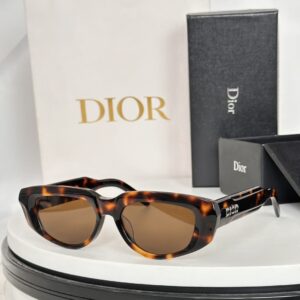Understanding Counterfeit Sunglasses: An Overview
The proliferation of counterfeit sunglasses is a notable concern within the eyewear market, largely driven by the allure of brand prestige combined with the lower price points associated with knockoff products. Counterfeit sunglasses often mimic established designer labels, appealing to consumers seeking the aesthetic of luxury at a fraction of the cost. This scenario has, unfortunately, fostered a thriving market for counterfeit goods, with significant economic implications. The International Chamber of Commerce estimates that counterfeit trade could encompass up to 3.3% of global trade, indicating a substantial impact on legitimate eyewear manufacturers and the economy at large.
Beyond the economic aspect, consumer safety is a critical factor in the discussion surrounding counterfeit sunglasses. Many of these fake products do not adhere to safety and quality standards, potentially risking ocular health. The absence of protective UV coatings in counterfeit eyewear is particularly alarming, exposing users to harmful rays that can lead to serious eye conditions, including cataracts and macular degeneration. The lack of regulatory oversight for these products exacerbates the risks consumers face, as they may lack vital information regarding proper usage and care.
Environmental concerns also merit attention, as the production of counterfeit sunglasses typically involves unsustainable practices. Many counterfeit manufacturers cut corners, resulting in excessive waste and pollution during the manufacturing process. This practice not only contributes to global pollution but undermines the efforts of legitimate companies that invest in sustainable production methods. As the eyewear market continues to expand globally, with regions like Asia, Europe, and North America significantly impacted by illegal manufacturing, the urgency for effective countermeasures becomes increasingly critical. Understanding the scope of the counterfeit sunglasses issue sets the foundation for exploring regional legislative responses and enforcement strategies aimed at mitigating this pervasive problem.
Regional Approaches: North America
North America is taking significant strides in combating counterfeit sunglasses through well-defined legislative frameworks and stringent enforcement mechanisms. In the United States, the Lanham Act serves as a critical piece of legislation that protects trademarks by allowing brands to sue for damages related to counterfeit goods. This Act not only provides remedies for trademark owners but also acts as a deterrent against the distribution of counterfeit products, including sunglasses.
Another relevant piece of legislation is the Consumer Product Safety Act, which ensures that manufactured goods, such as sunglasses, meet certain safety standards. This Act empowers the Consumer Product Safety Commission (CPSC) to act against products that pose safety risks, helping to keep counterfeit sunglasses off the market. In addition to these federal laws, various states have implemented their statutes to provide further protection against infringements, highlighting a multi-tiered approach to enforcement.
Law enforcement agencies at both federal and state levels play essential roles in tackling the counterfeit sunglasses trade. Agencies such as the Federal Bureau of Investigation (FBI) and the United States Customs and Border Protection (CBP) focus on intercepting counterfeit products at entry points and pursuing those who distribute them. The CBP, in particular, has been pivotal in recent years, conducting numerous operations to seize fake sunglasses being imported illegally into the country.
Recent case studies further illustrate the effectiveness of these enforcement efforts. For example, several successful operations have resulted in the seizure of thousands of counterfeit sunglasses, preventing them from reaching consumers and causing harm to genuine brands. These concerted efforts reflect a commitment to preserving brand integrity and consumer safety, establishing North America as a region that is actively addressing the grave issues associated with counterfeit products.
Combatting Counterfeits in Europe
The European Union has established a comprehensive framework to combat counterfeiting, particularly in the realm of sunglasses, which is a significant market affected by this issue. Central to these efforts is Regulation (EU) No 608/2013, which empowers customs authorities to prevent the entry of counterfeit goods into the EU market. This regulation outlines the procedures for customs to act upon suspicions of counterfeit goods, thus safeguarding intellectual property rights in a timely manner. The regulation not only benefits brand owners but also enhances consumer protection, fostering trust in legitimate products.
In addition to regulatory measures, the European Union actively promotes collaboration among its member states to create a unified front against counterfeiting. One such initiative is the Anti-Counterfeiting Action Plan, which aims to enhance cooperation between different national authorities, foster information sharing, and strengthen enforcement capabilities. By working together, EU countries can more effectively tackle the sophisticated methods that counterfeiters employ, ensuring that effective measures are applied uniformly across the region.
Several case studies exemplify the success of enforcement actions within key European markets. For instance, numerous large-scale operations have led to significant seizures of counterfeit sunglasses, illustrating the efficacy of customs interventions. In 2022, a notable operation in France resulted in the interception of over 50,000 pairs of counterfeit sunglasses. Such successes not only deter future counterfeiting activities but also send a clear message to consumers about the risks associated with purchasing counterfeit products.
Overall, the combination of robust legislation, collaborative efforts between member states, and decisive enforcement actions contribute substantially to the combat against counterfeit sunglasses in Europe. By maintaining vigilance and prioritizing intellectual property rights, the EU seeks to protect consumers and legitimate businesses from the adverse effects of counterfeiting.
Asia’s Challenge: Balancing Growth and Regulation
The eyewear market in Asia is experiencing unprecedented growth, a trend that simultaneously brings forth significant challenges related to counterfeit products, particularly counterfeit sunglasses. Countries such as China are recognized as major producers of counterfeit goods, raising hurdles in the enforcement of intellectual property (IP) laws. The complexity of the issue is heightened by the rapid pace at which the market expands, often outstripping the capacity of regulatory frameworks to cope with burgeoning demand and production. Chinese manufacturers, in some instances, exploit the absence of stringent regulations, leading to widespread distribution of counterfeit sunglasses that severely undermine brand integrity and consumer safety.
In contrast, Japan presents a different approach to addressing counterfeit challenges through stringent customs regulations. The Japanese government has established robust measures to intercept counterfeit goods at borders, thus limiting their entry into the market. Additionally, Japan has augmented its enforcement mechanisms by engaging in collaborations with both brands and consumer advocacy groups. These partnerships aim to reinforce consumer education regarding the risks associated with counterfeit products—spreading awareness about the implications of purchasing such items, which can range from substandard quality to safety hazards.
To confront the challenges posed by counterfeiting effectively, several Asian countries are not merely relying on enforcement alone but are actively fostering international partnerships. Through these collaborations, governments and brands work together on public awareness campaigns that underscore the importance of purchasing genuine eyewear products. These initiatives aim to inform consumers about the distinct advantages of authentic sunglasses, which include better quality, warranty coverage, and safety features. By striking a balance between fostering market growth and implementing regulatory measures, Asian nations are paving the way to combat counterfeit sunglasses while promoting legitimate industry practices.



